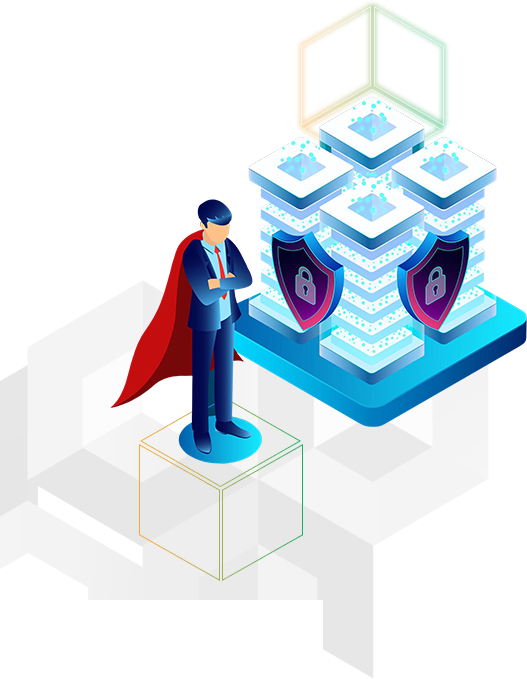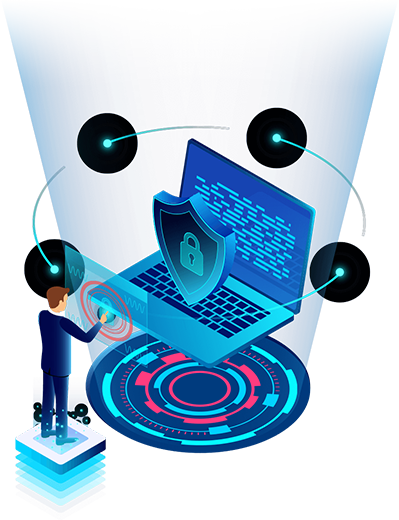Services & Solutions
Expert guide on Cybersecurity
Services We Offer
- Managed Detection & Response (MDR)
- Security Information & Event Management (SIEM)
- User and Entity Behavioral Analytics (UEBA)
- Endpoint Detection & Response (EDR)
- Network Detection & Response (NDR)
- Security Automation, Orchestration & Response (SOAR)
- Security & Compliance Consulting & Product Sourcing
Managed Detection and Response (MDR), Extended Detection and Response (XDR), and Security Operation Center as a Service (SOC as a Service)
360 SOC can help your organization leverage your current security technologies and integrate them into our Award Winning “360 SOC” a SOC as a Service platform.
360 SOC platform is made up of Gartner Magic Quadrant Leaders. We aggregate these technologies to deliver an efficient, reliable, and cost-effective solution to organizations of any size.

What is Managed Detection and Response?
- Managed Detection and Response (MDR) is a cybersecurity service that helps organizations proactively protect against cyber threats. It combines advanced technology with expert human analysis to continuously monitor networks and endpoints for malicious activity and suspicious behavior, and provides a comprehensive and accurate assessment of potential threats.
- MDR provides organizations with a proactive approach to security, actively searching for potential threats and alerting them to potential issues before they become major problems. It also has built-in response capabilities to help mitigate the impact of a security incident, such as the ability to isolate infected devices or block network communication.

The MDR service is typically provided by a team of experienced cybersecurity professionals who are trained to identify and understand the nuances of cyber threats. This team is responsible for monitoring the organization's systems and networks, analyzing potential threats, and coordinating the appropriate response actions.

MDR is an ideal solution for organizations that do not have the resources or expertise to manage their own cybersecurity in-house, or for those that want to augment their existing security capabilities with a more comprehensive and proactive approach. It provides organizations with the peace of mind of knowing that their systems and data are being continuously protected against cyber threats.

Some Key Features of MDR Include
- Continuous monitoring: MDR continuously monitors an organization's network and endpoints for malicious activity and suspicious behavior, providing a constantly updated view of potential threats.
- Threat detection: MDR uses advanced technologies such as machine learning and behavioral analysis to identify potential threats, such as malware and ransomware.
- Expert analysis: MDR combines the capabilities of advanced technology with the expertise of human analysts, who are trained to identify and understand the nuances of cyber threats. This combination of technology and human analysis allows MDR to provide a more comprehensive and accurate assessment of potential threats.
- Response capabilities: MDR has built-in response capabilities, such as the ability to isolate infected devices or block network communication, to help mitigate the impact of a security incident.
- Proactive approach: MDR takes a proactive approach to security, actively searching for potential threats and alerting organizations to potential issues before they become major problems.
- Integration with other security solutions: MDR can be integrated with other security solutions, such as firewalls and intrusion prevention systems, to provide a comprehensive view of an organization's security posture.

24 x 7 x 365
360 SOC is built to monitor critical security events day and night including holidays. (8×5 management also available)

Aggregated Stack Difference
360 SOC is the industry's ONLY Aggregated Insider Threat Security Stack that is Fully Customizable
What is SOC as a Service?
Security Operation Center (SOC) as a Service is a cybersecurity solution that provides organizations with access to a team of security experts and advanced security technologies to help protect against cyber threats. It is designed to be a comprehensive and proactive approach to security, continuously monitoring networks and endpoints for malicious activity and suspicious behavior, and providing a rapid response to potential threats.
Some key features of SOC as a Service include:
- Continuous monitoring: The SOC team continuously monitors an organization's networks and endpoints for malicious activity and suspicious behavior, providing a constantly updated view of potential threats.
- Expert analysis: The SOC team is made up of experienced cybersecurity professionals who are trained to identify and understand the nuances of cyber threats. They use advanced security technologies, such as machine learning and behavioral analysis, to identify potential threats and provide a comprehensive and accurate assessment of the risk they pose.
- Proactive approach: The SOC team takes a proactive approach to security, actively searching for potential threats and alerting organizations to potential issues before they become major problems.
- Response capabilities: The SOC team has the expertise and resources to coordinate an effective response to potential threats, including taking actions such as isolating infected devices or blocking network communication.
- Integration with other security solutions: The SOC team can be integrated with other security solutions, such as firewalls and intrusion prevention systems, to provide a comprehensive view of an organization's security posture.
Overall, SOC as a Service is a valuable solution for organizations that want to enhance their security posture with a proactive and comprehensive approach to detecting and responding to cyber threats.

What is Extended
Detection and Response (XDR)?
Extended Detection and Response (XDR) is a cybersecurity solution that combines advanced technologies and expert human analysis to detect and respond to cyber threats across an organization’s entire IT environment. It is designed to provide a comprehensive and proactive approach to security, enabling organizations to identify and respond to potential threats before they become major problems.
XDR typically includes a range of capabilities and features, such as:
- Continuous monitoring: XDR continuously monitors an organization's networks, endpoints, servers, and applications for malicious activity and suspicious behavior, providing a constantly updated view of potential threats.
- Threat detection: XDR uses a combination of machine learning algorithms and expert analysis to identify potential threats, such as malware, ransomware, and insider threats. It provides alerts to security teams when it detects a potential threat, enabling them to take appropriate action to mitigate the risk.
- Response capabilities: XDR has built-in response capabilities, such as the ability to isolate infected devices or block network communication, to help mitigate the impact of a security incident. It also provides tools for coordinating and managing the response to a security incident, including incident prioritization, assignment, and resolution.
- Integration with other security solutions: XDR can be integrated with other security solutions, such as firewalls, intrusion prevention systems, and threat intelligence feeds, to provide a comprehensive view of an organization's security posture.
- Expert analysis: XDR is typically provided by a team of experienced cybersecurity professionals who are trained to identify and understand the nuances of cyber threats. They are available to provide expert analysis and support to help organizations respond to and mitigate potential threats.

Why Are Company's and Organizations Quickly Aligning with SOC as a Service and MDR Vendors?
SOC as a Service is often used by organizations that do not have the resources or expertise to maintain an in-house SOC, or who want to supplement their existing security measures with additional monitoring and support.
There are several reasons why organizations might purchase SOC as a Service:
- Cost savings: Outsourcing security operations to a third-party provider can be more cost-effective than maintaining an in-house SOC, especially for smaller organizations with limited budgets.
- Expertise: SOC as a Service providers often have highly trained and experienced security analysts and engineers who can identify and respond to threats more effectively than an in-house team.
- Scalability: SOC as a Service can be easily scaled up or down to meet an organization's changing security needs, without the need to hire additional staff or invest in new infrastructure.
- 24/7 coverage: With SOC as a Service, organizations have access to around-the-clock monitoring and support, ensuring that their systems are protected at all times.
- Compliance: SOC as a Service providers can assist with compliance efforts, helping organizations to meet regulatory requirements and industry standards.
What is the Gartner SOC Triad Methodology?
The Gartner SOC Triad Methodology is a framework that helps organizations to design and implement a Security Operations Center (SOC). It is based on three key pillars: people, process, and technology.
The people pillar involves building a team of skilled and experienced security professionals who can handle the various tasks and responsibilities of the SOC, such as monitoring and analyzing security events, incident response, and reporting.
The process pillar involves defining and implementing standard operating procedures and processes for the SOC, such as incident response, threat intelligence, and reporting. The technology pillar involves selecting and implementing the appropriate tools and technologies to support the SOC, such as security information and event management (SIEM) systems, intrusion detection and prevention systems (IDPS), and threat intelligence platforms.
Organizations looking to build a SOC may choose to follow the Gartner SOC Triad Methodology because it provides a structured and comprehensive approach to building and maintaining a SOC. It helps organizations to ensure that they have the right people, processes, and technology in place to effectively monitor and protect their networks and systems.


Some Say MDR
Some Say SOC as a Service, Some Say MSSP...
Managed Detection and Response (MDR) is a security service that involves the continuous monitoring of an organization’s networks and systems to detect and respond to security threats. MDR providers use a combination of technologies, such as security information and event management (SIEM) systems and intrusion detection and prevention systems (IDPS), as well as human analysts, to monitor for and respond to security incidents.
MDR services typically include:
- Continuous monitoring of an organization's networks and systems for security threats
- Alerts and notifications when potential threats are detected
- Investigation and analysis of security incidents to determine their severity and impact
- Recommendations for remediation and prevention of future threats
- Assistance with incident response and containment
- Reporting and documentation of security incidents and response efforts
MDR is typically deployed as an on-premises solution or as a cloud-based service, and is usually tailored to an organization’s specific security needs and requirements. It is well-suited for organizations that require a high level of monitoring and threat detection, as well as those that do not have the resources or expertise to maintain an in-house security operations center (SOC).
Security Operations Center as a Service (SOC as a Service) is a managed security service that provides organizations with access to a team of security professionals who can monitor and protect their networks and systems. SOC as a Service can include a wide range of services, such as incident response, threat intelligence, and compliance support. It is typically provided as a cloud-based service and may not include as comprehensive or frequent monitoring as MDR. SOC as a Service may be more suitable for organizations that need a wider range of security services and support, or that do not have the resources or expertise to maintain an in-house SOC.
Overall, SOC as a Service is a valuable solution for organizations that want to enhance their security posture with a proactive and comprehensive approach to detecting and responding to cyber threats.

Top 10 Reason to Buy 360 SOC MDR...
- 24/7 monitoring: Our team of security experts is on duty around the clock, monitoring your systems for threats and providing rapid response if an incident occurs.
- Proactive threat hunting: Our team uses advanced tools and techniques to proactively hunt for threats that might have slipped past your defenses.
- Advanced threat intelligence: We stay up-to-date on the latest threats and trends in the cybersecurity landscape, and use that intelligence to protect your organization.
- Comprehensive protection: Our MDR service covers all layers of your security stack, including endpoint, network, and cloud.
- No upfront costs: We offer flexible pricing options, including a pay-as-you-go model with no upfront costs.
- Scalability: Our MDR service is designed to scale with your organization, so you can get the protection you need as your business grows.
- Expertise: Our team is composed of highly trained and experienced security professionals who are dedicated to protecting your organization.
- Customized solutions: We work with you to understand your unique security needs and tailor our MDR service to meet them.
- Comprehensive reporting: We provide regular reports on the state of your security, including threats detected and remediated.
- Peace of mind: With 360 SOC MDR, you can have peace of mind knowing that your organization is protected by a team of security experts.
Why 360 SOC?
At 360 SOC, we understand that no two organizations have the same security needs and requirements. That’s why we offer both Managed Detection and Response (MDR) and Security Operations Center as a Service (SOC as a Service), tailored to meet your unique security requirements. Our team of experts will work with you to understand your organization’s specific security needs and goals, and design a customized solution that delivers the protection and support you need to stay safe from cyber threats. With 360 SOC, you can feel confident that your organization’s networks and systems are in good hands, and that you have the tools and resources you need to effectively detect and respond to any security incidents.


